Interview with Patricia Danzon (Wharton)
by George Rozanski (Bates White)
Prof. Patricia Danzon (Professor of Health Care Management, The Wharton School, University of Pennsylvania), has been interviewed by Dr. George Rozanski (Partner, Bates White Economic Consulting) in anticipation of the Antitrust in Life Sciences conference, to be held in New York on 23 March 2020. You can access the interview below, and join the conference for free to hear more.
Market definition: Antitrust agencies and plaintiffs typically assess effects on competition by first defining markets. In the case of pharmaceuticals, the FTC has defined markets for generic drugs quite narrowly – based on the molecule, form, and strength. In the case of drugs that are still on patent, drugs intended to treat the same condition and with similar indications may be considered to be in the same market, even though they may be differentiated in terms of side effects or in other ways that are significant for some patients. When this is the case, what methods and types of evidence are available to assess the extent of substitution between two different drugs, especially given that consumers and their doctors may not respond to prices or even be faced with prices? Should market definition rely on evidence of substitution or steering by agents for payers, such as insurance companies and PBMs?
Market definition for pharmaceuticals is not easy. For generic drugs, the narrow definition using molecule, form and strength makes sense, at least for the short run, because this defines the scope within which pharmacies can substitute bioequivalent generics without seeking permission from the prescribing physician. For drugs that are still on patent, a starting point for market definition is drugs that are indicated (FDA-approved or potentially approvable) to treat the same medical condition(s). In some cases it may be appropriate to also consider other factors that limit substitutability e.g. drugs that have very different mechanisms of action or different routes of administration (injection vs. oral) may differ systematically in side effects, convenience etc.
However, reliance on actual substitution data is problematic for several reasons. First, substitution is typically greater for new patients than for established patients who may be reluctant to switch from a drug that is familiar and working for them, so substitutability increases with time but this varies across therapeutic categories; second, to the extent that patients face prices, these are usually co-payments that are a small fraction of the full price and depend on the formulary decisions of their PBMs or insurers, which may only be revised annually; third, these formulary decisions made by PBMs are influenced by their own financial incentives, in terms of rebates and other margin payments. These financial incentives or “prices” faced by payers are generally unobservable to analysts. Thus structuring an empirical analysis to measure substitution is conceptually complex (which decision-makers and which prices) and empirically problematic (unobservability of prices, controlling for promotion and other non-price influences on demand ). If one or more of the potential competitors has not yet been approved, empirical measurement is not even a possibility.
|
|

